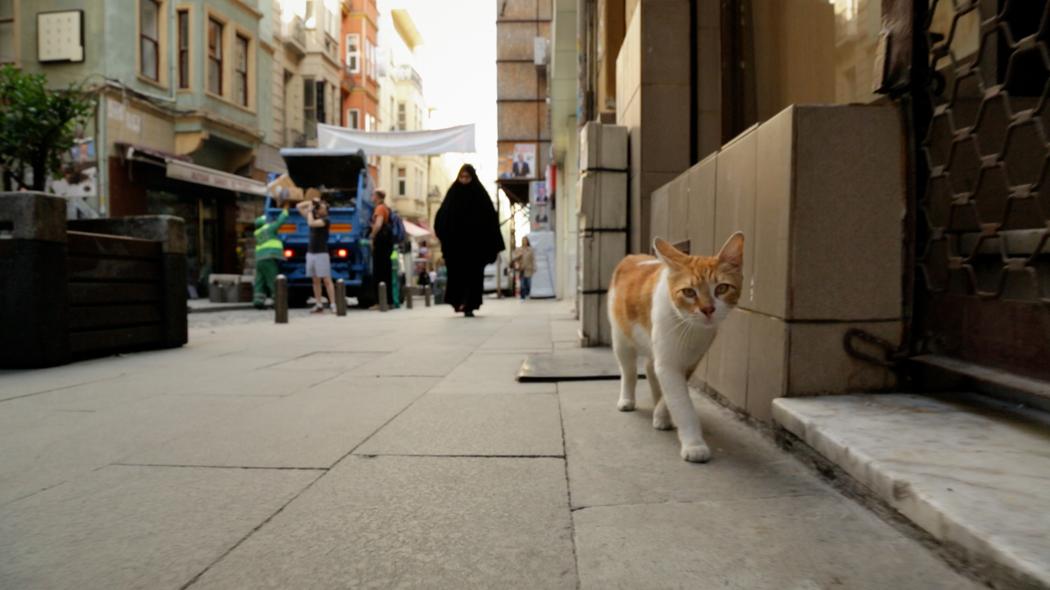A Turkish friend has told me that her greatest culture shock upon coming to New York from Istanbul was the absence of street cats as a part of daily life – cats, she said, that people take it on themselves to care for, but who come and go independently, with no real sense of “masters” or “owners.” Here, of course, the feral, or stray, population exists, but is something to be “controlled” and, because it is, for better or worse, controlled, not pervasive. Now KEDI, a documentary by Ceyda Torun about Istanbul street cats, has come to New York, and it is unmeowably wonderful.
As filmmaking, KEDI is rapturous, with aerial shots of red-roofed neighborhoods, gorgeous views of the Bosphorus, cat lives portrayed with picaresque charm, the animals photographed, somehow, by the cinematographer Charlie Wuppermann, with no awareness of the camera, nary a distracted eye nor a paw batting off the lens (one wants, of course, to see the outtakes). Thematically, it posits a sort of interspecies sociology, an interweaving of cat and human that is spiritual, religious, psychological, economic, and historical. Dramatically, it is deeply entertaining, alternately affecting and amusing, especially to those who know and like cats, but also to anyone who values storytelling drawn from the everyday. The cat tales draw you into the human ones with which they are entwined.
The stories are character driven, by both cats and people. Most of the cats profiled have attached themselves to businesses or persons at work but they visit or come and go from homes as well. There is the cat who led the boater whose vessel was wrecked to enough money to get back on his sea legs; the restaurant owner with a mouse problem whom a cat in need providentially obliges; a troubled woman (we would call her a “cat lady”) who works out her fears through the cats she lives with and feeds on the streets; a tomcat who takes it on himself to warm an abandoned litter. There’s a “gentleman” cat at a gourmet café who neither bothers the customers nor enters the shop even when the door is open. He “knocks” on the window when he’s hungry (the pawing looks like some sort of OCD kitty cipher, but, fair enough, he gets his food).
It would be easy to say that the real subjects of the film are the humans, that it is about what, in other words, the cats say about homo sapiens. Some care for the cats out of a sense of moral, often religious, obligation. Cats, one man asserts, know there is a god, while dogs do not; humans are intermediaries between the feline and the divine. Again and again the humans view the cats with profound gratitude. The cats assuage loneliness and model, if not self-sufficiency, then choice, determination, and individuality. There is a sort of ethical behavior in their territoriality, giving and receiving of affection, standoffishness, and reciprocity of exchange, be it food for rat control, shelter for love, or humane care for divine approbation. They add a pathos to present controversies, such as the incursion of development onto green space and its effect on lives both human and feline.
Still, KEDI is meant to be and is about the cats. No one will go to it for any other reason. Human words tell the stories but so, at the nub, do the images of cats. A thousand tales are writ in their cubist, too-close-together eyes; their mal-proportions and evident past injuries; their scoping out of routes to, from, and between streets, trees, rooftops, and windows; their sloth like slowness and lightning swiftness. And in that which is behind those eyes, inside those lithesome frames, the logic of their schemes and their moments of decision, even if we cannot know, ever or ultimately, what it is to be, feel, or think as they. The film ends, like a near death experience, with a recap of the cats and people we have met, but it is the cats we want most to see again.
Torun is a cat lover. She has said that but for street cats she would have had a lonely childhood. There is not much bow in KEDI to haters, to those who, as another Turkish friend has confided to me, regard cats as lots of New Yorkers do rats. An opening title suggests that those who despise or are indifferent to them must still acknowledge their cultural importance. One of the people in the film says that street cats might be seen as a problem that needed to be solved, but concludes, provocatively, that to confine cats to homes is make them less cats. This suggests, if cats were people, a feline identity politics. Ensure us equality in the system but don’t strip us of what we are. “Kedi” is Turkish for “cat.”
Check listings for viewing options. KEDI is playing at Metrograph in New York. Promotional still from Oscilloscope Laboratories .
